Wind tunnel tested: Which aero road wheels are the fastest?
We found the fastest, but our findings only created more questions
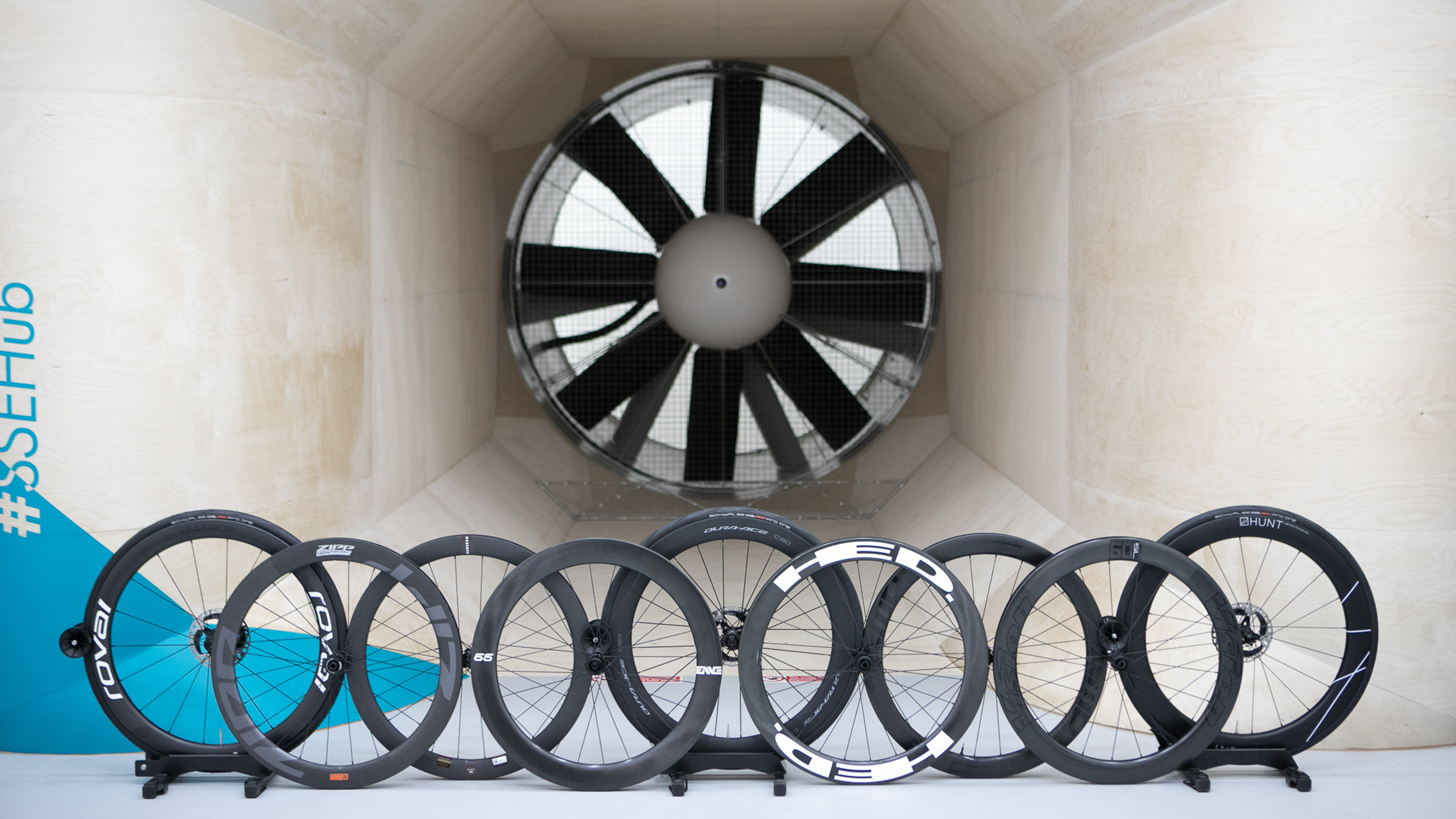
A more recent edition of this test was performed in November 2024, in which we took 18 wheelsets (including a mix of newer models and some of those found here) for a more thorough and up-to-date test.
Head to our 2024 wind tunnel wheels test to read that article.
The data in the article below is still valid.
When it comes to buying aero wheels for a road bike, there are a few considerations cyclists need to make. Compatibility with your bike, groupset and brakes are naturally going to be top of the priority list to ensure you can actually use them, but that's not exactly why we're buying them in the first place, is it? Tyre compatibility is another factor, and while we all get passionate when discussing why we prefer tubeless or clincher tyres over the other, it's still not what gets our blood pumping.
There are two main motives when it comes to choosing the best road bike wheels: those worried about riding uphill will focus on weight, likely before rattling off a rant about rotating weight being worth double (a still annoyingly common myth), but for the majority of us, the most important metric will be aerodynamics. Want to go faster for less effort? Of course you do.
Brands know this, so rare is the day that a brand launches a new set of aero road bike wheels without some sort of claim about how they're faster than their predecessor or the competition. The claim often originates from some sort of wind tunnel or aerodynamics testing, and looks something like "these new wheels are three watts faster than…" or "will save you 32 seconds over a 40km time trial". Naturally, we are forced to take these claims with a pinch of salt, as each brand is biased towards marketing its own product.
With that in mind, when we were invited to Silverstone Sports Engineering Hub wind tunnel and offered the chance to bring a few wheelsets along, we jumped at the chance to be able to provide independent testing across various different wheelsets. We reached out to as many brands as possible and managed to get our hands on 10 pairs, and we've outlined the results below.
Get The Leadout Newsletter
The latest race content, interviews, features, reviews and expert buying guides, direct to your inbox!
Aerodynamics is measured in CdA, or the Coefficient of drag x Area, which is quantified in metres squared, or M². The drag coefficient is effectively a definition of how easily air passes over an item's surface. This is primarily affected by the shape of the item - for example, a bullet will have a lower drag coefficient than a coin, even when their size (or Area) is the same, due to its shape - but it can also be affected by surface material, and that's why many cyclists wear aero socks instead of bare legs. The area is quite simply the item's frontal area, or size.
To go faster, you need a lower CdA (in the context of aerodynamics, at least) and this can be achieved by making your area smaller, or by making it easier for air to pass over your surface - by adjusting your shape, making your surface smoother or by using clever fabrics. Put in simple terms, the less you can disturb the air through which you pass, the more aerodynamic you'll be.
Returning our focus to road bike wheels, there's an important balance to be struck with reducing CdA while also ensuring the wheels perform well in other areas, such as handling, comfort, and weight. For example, a solid wheel known as a disc wheel will regularly produce the lowest CdA numbers in a wind tunnel, but they are also considerably heavier than a spoked wheel and more affected by wind, which makes accelerating slower, the overall bike heavier, handling more difficult, and crashes more likely.
That's where mid-section wheels come into their own. Averaging around 50- to 65mm deep, these wheels aren't as aerodynamic as their 80- to 90mm deep counterparts, nor are they as light or responsive as the best lightweight wheels, which are often 30- to 40mm deep. They strike a Goldilocks balance and make for the ideal choice for most riders, who are looking for extra speed, without sacrificing handling ability or adding too much weight.
For that reason, we focussed our attention on mid-section wheels for our testing.
The wheels
We limited our testing to wheels ranging from 50 to 65mm, and our efforts resulted in the following list of 10 wheelsets:
- Shimano Dura-Ace C60 (R9200 series)
- Roval CLX II 60mm
- HED Vanquish RC6 Pro
- Hunt 60 Limitless Aero Disc
- Vision Metron 60 SL
- Enve Foundation 65
- Reserve 50/65
- FFWD Ryot 55
- Zipp 404 Firecrest (58mm)
- DT Swiss Arc 1100 DiCut 62 DB
The test
An admission: I didn't perform the testing myself. I was present and involved, but definitely not in charge of the wind tunnel. Even if I were allowed, I wouldn't have wanted to since the calibre of experts present on the day was immense. I was lucky enough to have Jamie Lowden, aerodynamics specialist at Wattshop, as well as Casper von Folsach, one of the aero masterminds behind the Danish federation's 2020 Olympics track success. They were both entirely happy to indulge our wheelset curiosity.
Naturally, the test was standardised, meaning the same conditions were met for each wheelset during each data capture. These included the bike, the wind speed, the tyres and more.
Each wheelset was fitted to the same frame for testing, without a rider present. However, prior to the test, we spent a long period of time testing various wheelsets with a pedalling rider. We saw very similar differences between wheels, but with increased noise (variance in the resulting CdA figures). To achieve the same accuracy of results across all of our testing, we would have needed a lot more testing time and repeats to get the same information. Having found the same differences with less noise using less testing time and fewer repeats, it was a no-brainer to continue the testing without a rider.
We tested with an airspeed of 45km/h (27.96mph). This is representative of professional peloton speeds. Naturally, we ensured the wheels were spinning at the same speed, because the behaviour of airflow over the rim and spokes is very different on a static wheel, and not at all representative of the real world.
Holding the bike in place was a set of stanchions, and no corrections were made for these, since they were the same across all tests. We're interested in the difference between wheels here, not the absolute values.
Each wheel was fitted with 25mm Schwalbe Pro One tubeless tyres. Some wheels in this test were designed to be fitted with 28mm tyres. We will note those as part of the results below.
Each data capture was performed in five-degree increments from -15 to +15 degrees of yaw. That means seven capture points of -15, -10, -5, 0, +5, +10 and +15 degrees. Each capture was performed in a sweep in the same direction (negative to positive) for consistency.
Some caveats
Below, you'll find the results of our day spent in the tunnel. However, first, a few caveats:
- I will order them from worst to best based on the average CdA across all seven yaw angles. I will then use this average to calculate the average power required to ride at 30km/h (18.64mph) and 40km/h (24.85mph) based on the following calculation: Power (watts) = 0.5 x AirDensity x CdA x Velocity^3.
- Given we have the CdA of the bike alone, rather than a bike with a rider on it, the actual CdA and wattage numbers are small. An approximate CdA for the best time triallists will be around 0.17, rising to around 0.3 for a road cyclist, whereas the CdA values here are between 0.09 and 0.1. The approximate wattage to ride at 40km/h here works out at around 78 watts, which is obviously unrealistic. So, instead of quoting that number, I've calculated the watts saved vs the slowest wheelset on this test.
- The results of our testing are representative of just that: our testing. We understand that manufacturers might find different results based on different testing protocols. We don't intend to claim that our results are the final word in road wheel aerodynamics testing, but rather a separate stream of independent testing and knowledge for our readers.
- We also understand that aerodynamics is just one of a number of factors that define the best road bike wheels. Weight, durability, width, crosswind stability, ease of servicing, how easily a tyre is fitted, and how easily a tubeless tyre seats and inflates are just some examples of other factors to bear in mind.
The results
With those caveats out of the way, let's get into what you're actually here for… the results.
10: Reserve 65/50
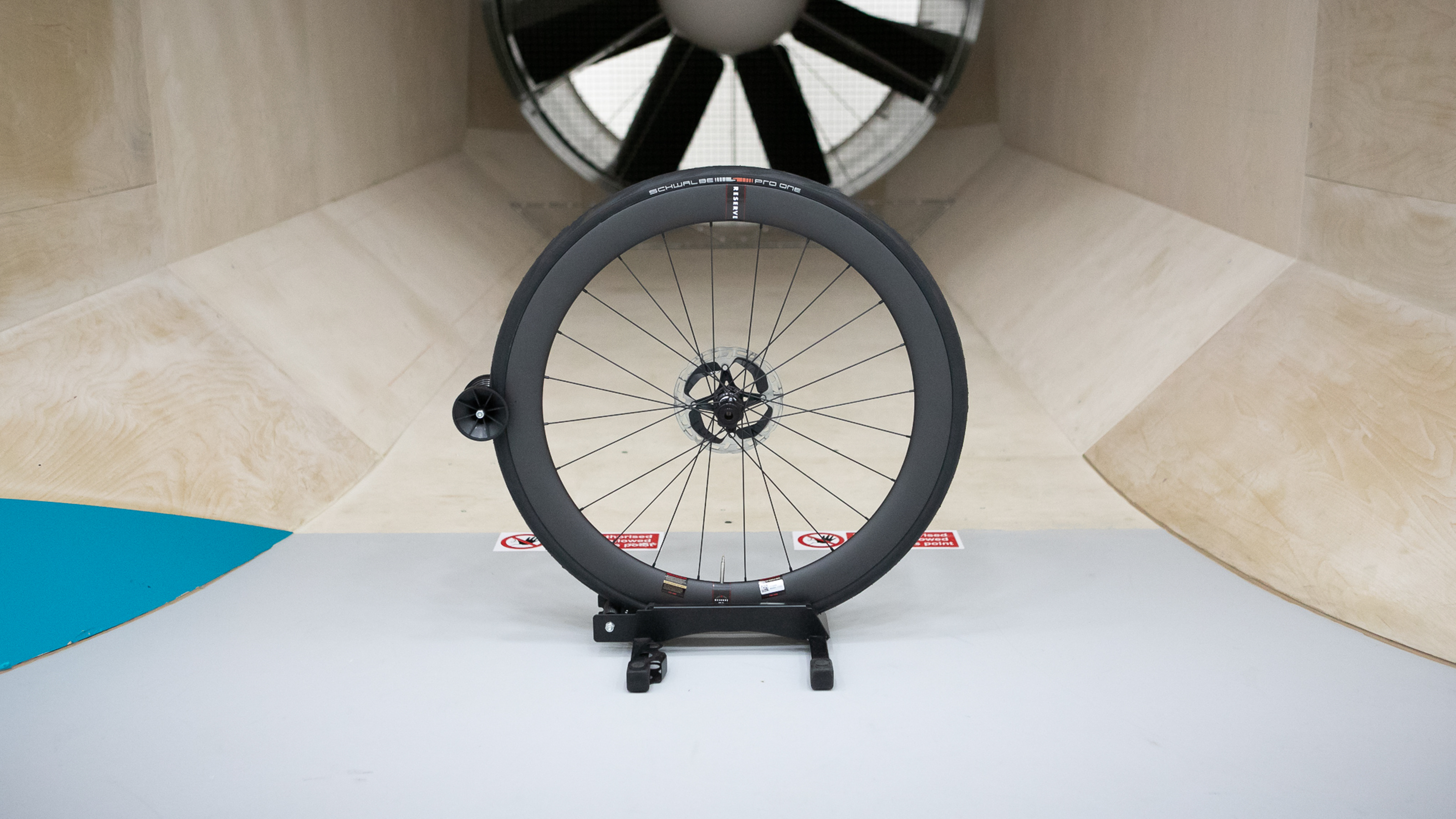
In 10th and last place in our testing comes a relative outsider to the mainstay wheel brands, Reserve, which is the subsidiary brand of Santa Cruz and Cervelo, and is the wheel sponsor to Jumbo Visma's women's team.
The brand very recently won the Green Jersey beneath Marianne Vos at the Tour de France Femmes, and was also used by Wout van Aert for his victory in the men's Tour de France stage 20 time trial. The wheelset in question is the 50/65 - essentially pairing a 50mm deep front wheel with a 65mm rear. Its +10 and +15 degree values actually came out slightly faster than both 8th and 9th place, but the average CdA across the board is 0.00007 higher (and therefore slower) than 9th place. Importantly, that's almost nothing at 0.06 of a watt.
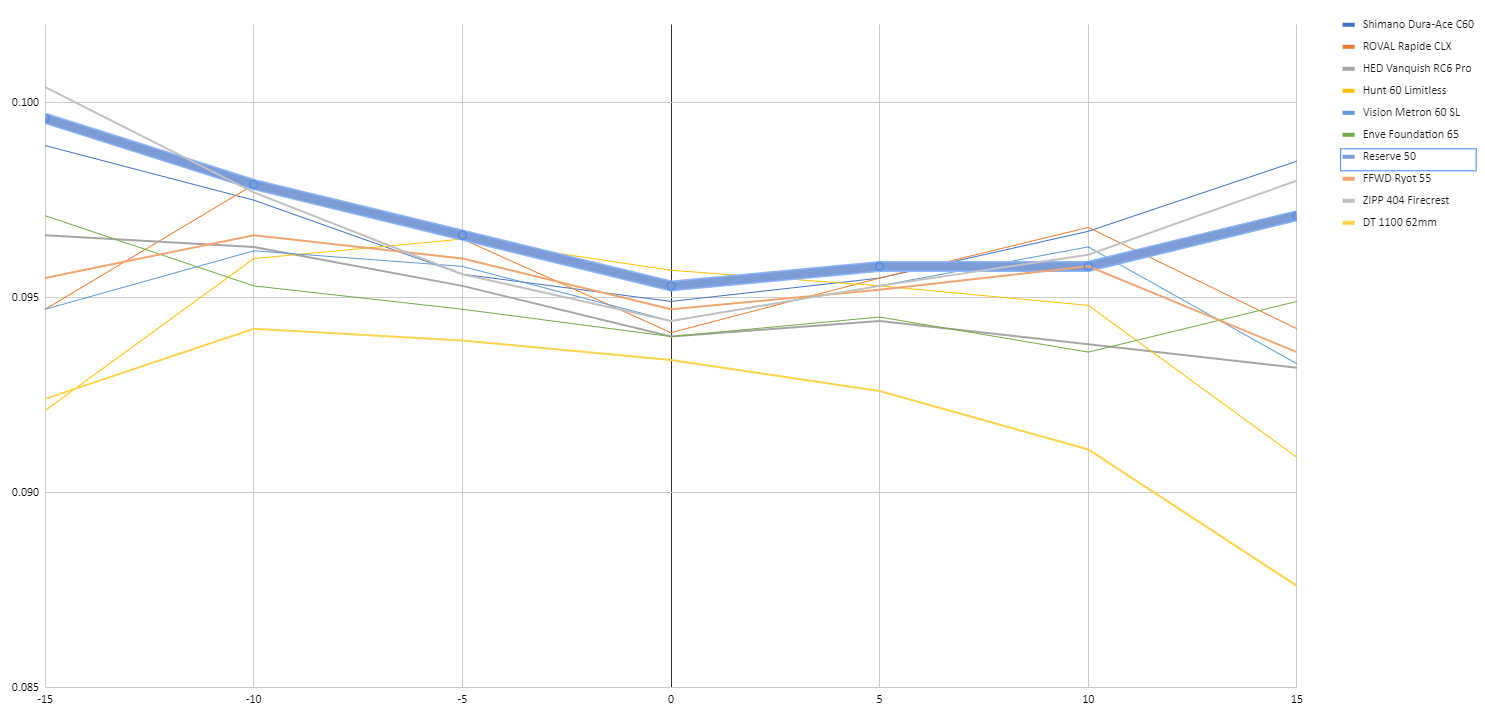
- Average CdA: 0.09687
- Rim depth: 50mm front / 65mm rear
- Internal rim width: 21mm
- Wheelset weight: 1670g
- Watts to hold 30kph: 33.6w
- Watts to hold 40kph: 79.7w
9: Shimano Dura-Ace C60 (R9200 series)
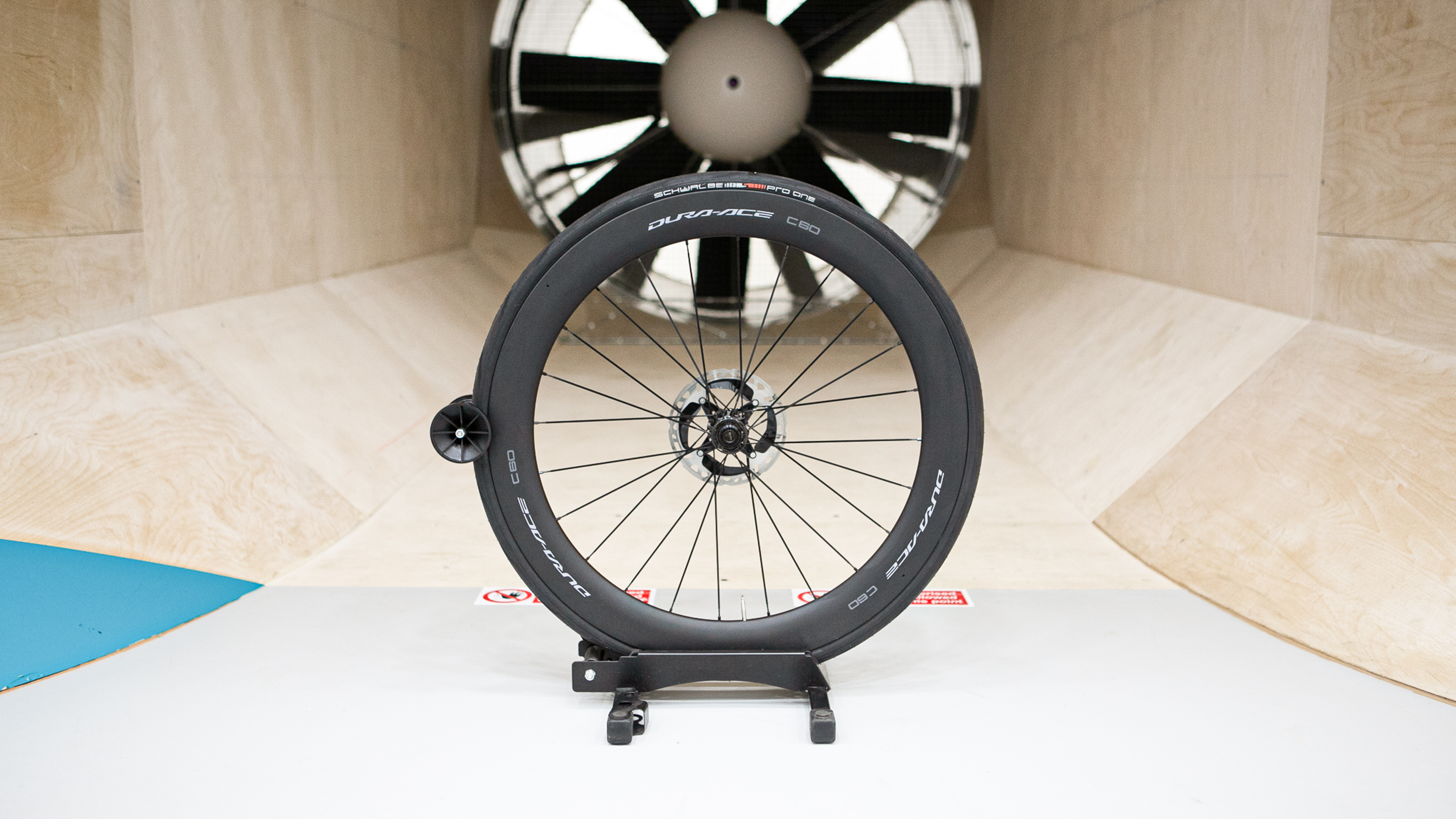
Rolling into 9th place comes the latest road wheelset from Shimano, the Dura-Ace R9200 C60, whose average CdA works out at 0.09680. Like all wheels in this test, these are the tubeless-ready clinchers, though these are also available in tubular form for the pros. At 60mm deep, they are neither the deepest, nor shallowest in this list.
As mentioned above, at 40km/h, they are 0.06 watts faster than the Reserve 50/65 wheels, which is not going to be noticeable in the real world. If you're trying to decide if the Shimano wheels are a worthy upgrade from the Reserve wheels that came fitted to your new Cervelo, you won't find the answers in the wind tunnel.
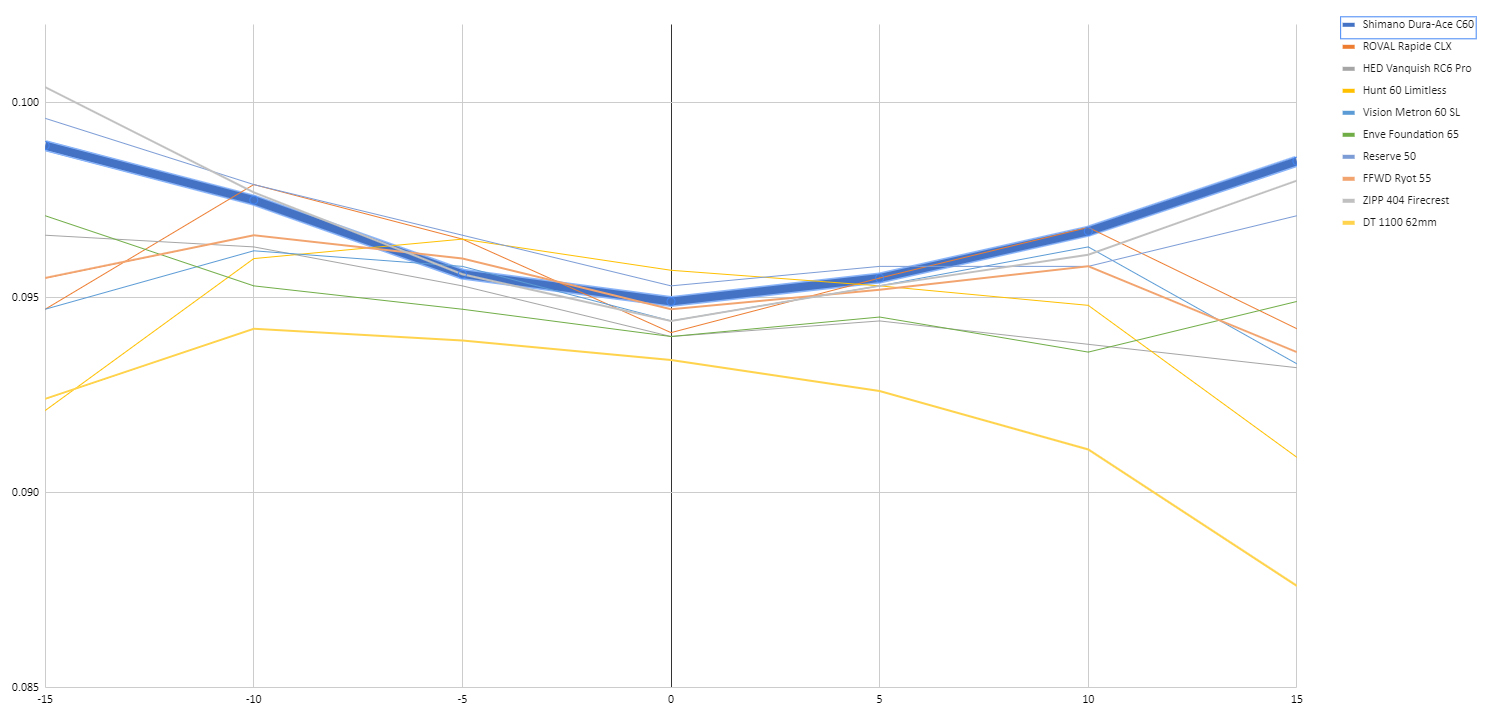
- Average CdA: 0.09680
- Rim depth: 60mm
- Internal rim width: 21mm
- Wheelset weight: 1609g
- Watts saved at 30kph: 0.02w
- Watts saved at 40kph: 0.06w
8: Zipp 404 Firecrest
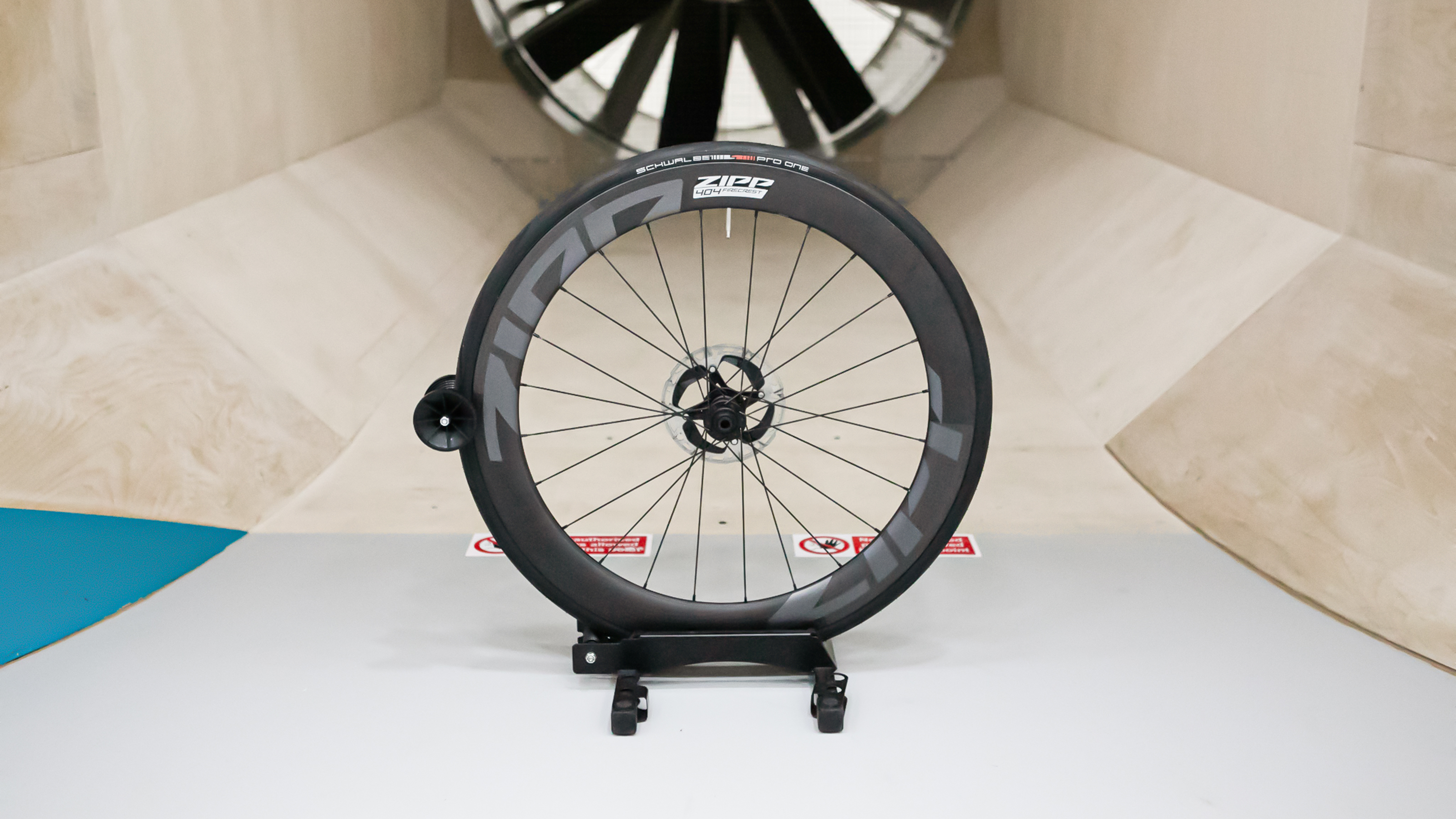
Squeezing into 8th place by the slenderest of margins is the mid-tier, mid-section option from Zipp, the 404 Firecrest. These are a little heavier than their wave-profile counterparts, the 454 NSW, but they get a more straightforward rounded rim shape and a hefty cost saving to boot. They have a comparatively wide internal rim width of 23mm, and that means they're best paired with a 28mm tyre.
In terms of their CdA score in our testing, their average was calculated to 0.09679, just 0.00001 better than Shimano. That's less than a tenth of a watt at 40km/h, and just 0.005 watts faster at 30km/h. As before, if you're trying to work out whether you should upgrade to Zipp or Shimano, look at other factors beyond the aerodynamic performance.
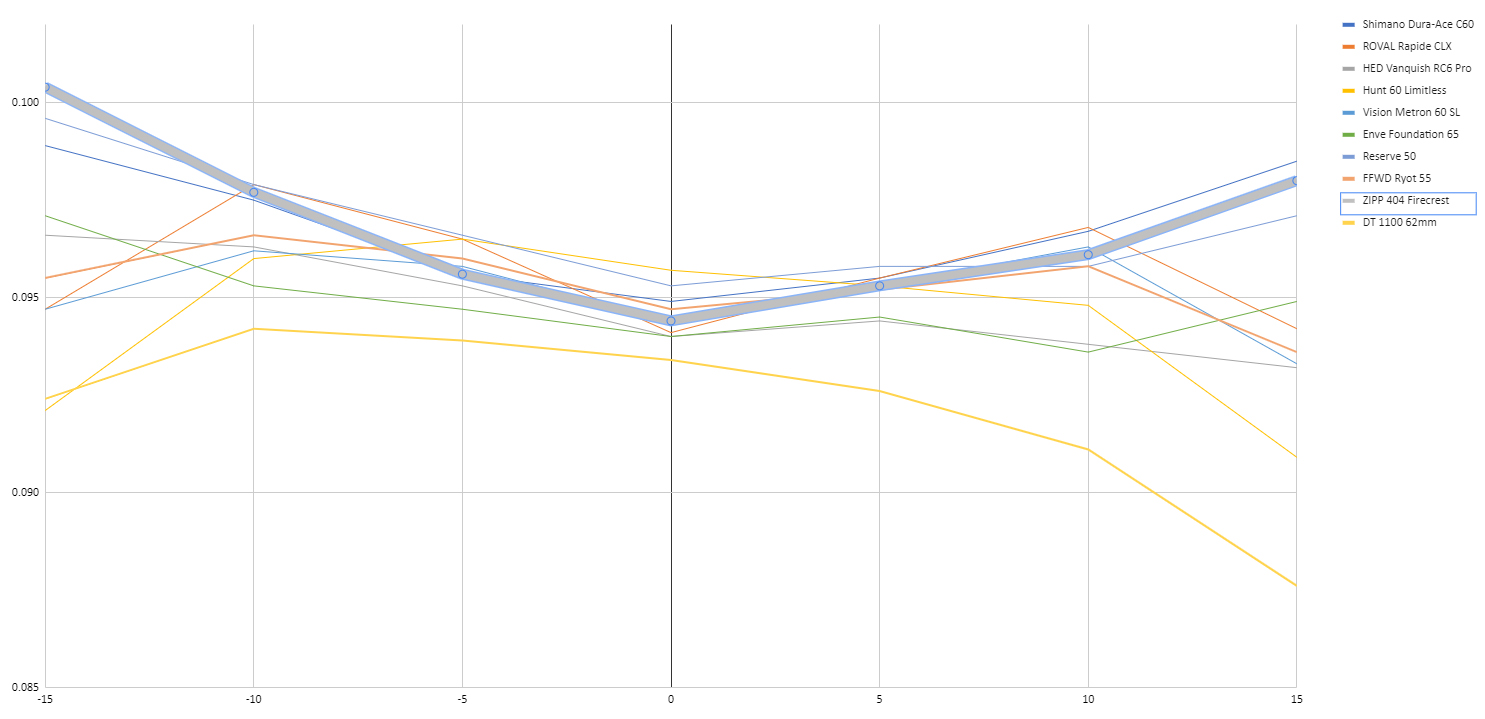
- Average CdA: 0.09679
- Rim depth: 58mm
- Internal rim width: 23mm
- Wheelset weight: 1500g
- Watts saved at 30kph: 0.03w
- Watts saved at 40kph: 0.07w
7: Roval Rapide CLX II
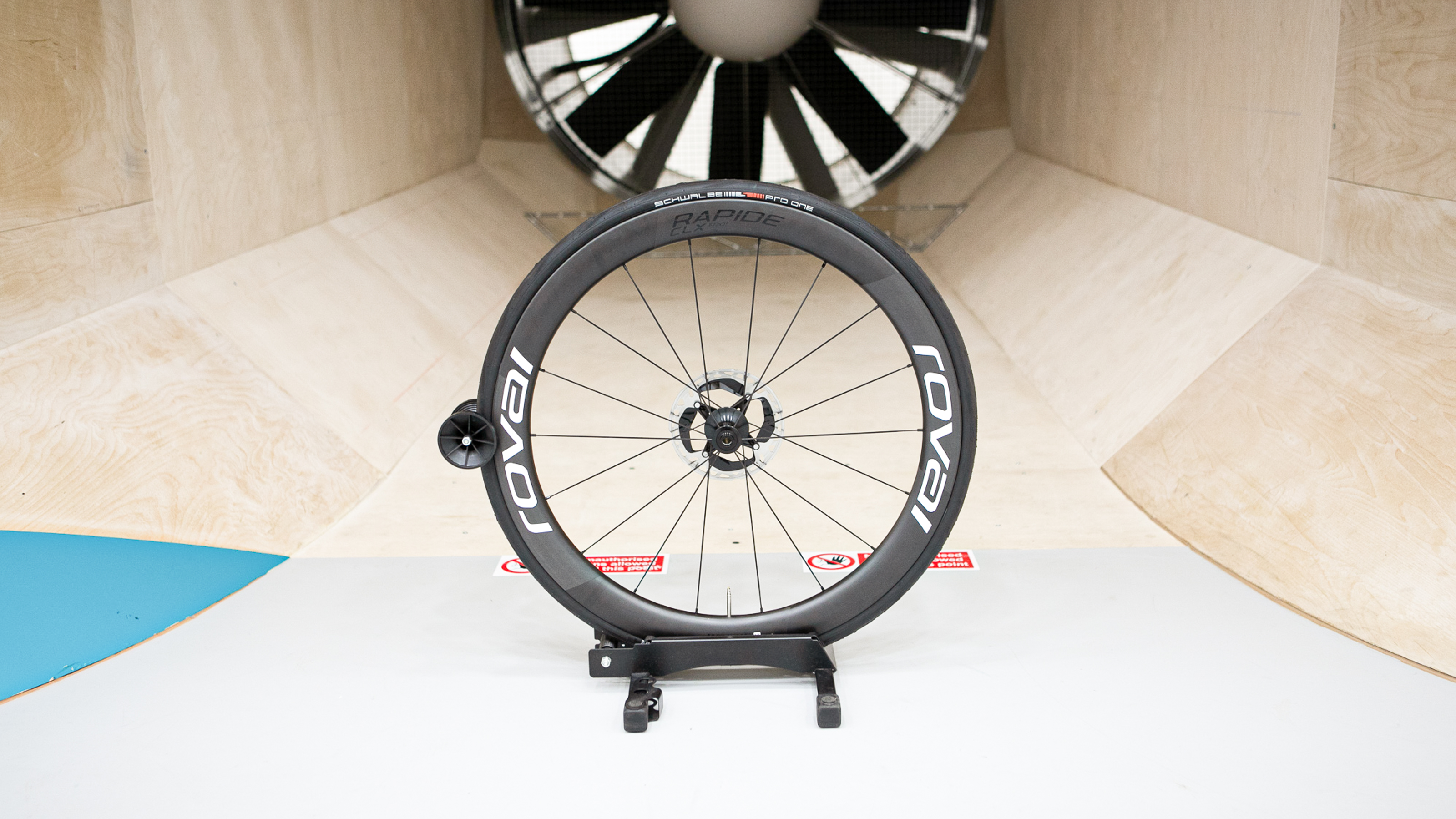
Next up comes the Roval Rapide CLX II, which was released this year to finally overturn its predecessor's incompatibility with tubeless tyres. These newly tubeless wheels are said to be safer, far surpassing the industry standards. Notably for our testing, they didn't change shape at all, so for those of you still using previous Rapide CLX wheels, you can assume the same result for those too.
Their CdA average was calculated at 0.09567, which is a larger step up in aero performance than we've seen so far. The difference is still pretty small, at just shy of 1w at 40kph. Notably, they are also 7mm shallower at the front, with a more blunt profile, which Specialized claims is intended to aid crosswind stability. They're also the lightest wheels we had on test, at 1410g.
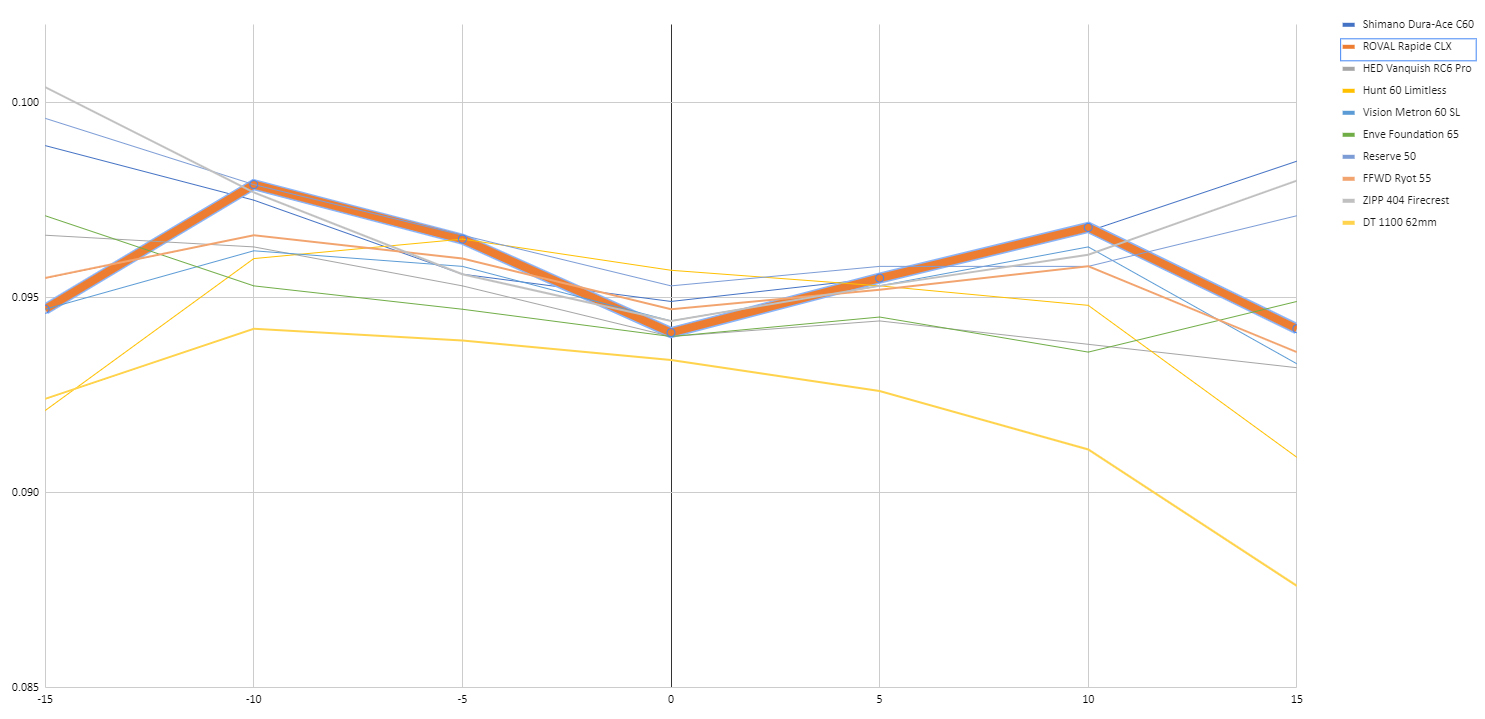
- Average CdA: 0.09567
- Rim depth: 51mm front / 60mm rear
- Internal rim width: 21mm
- Wheelset weight: 1410g
- Watts saved at 30kph: 0.42w
- Watts saved at 40kph: 0.99w
6: FFWD Ryot 55
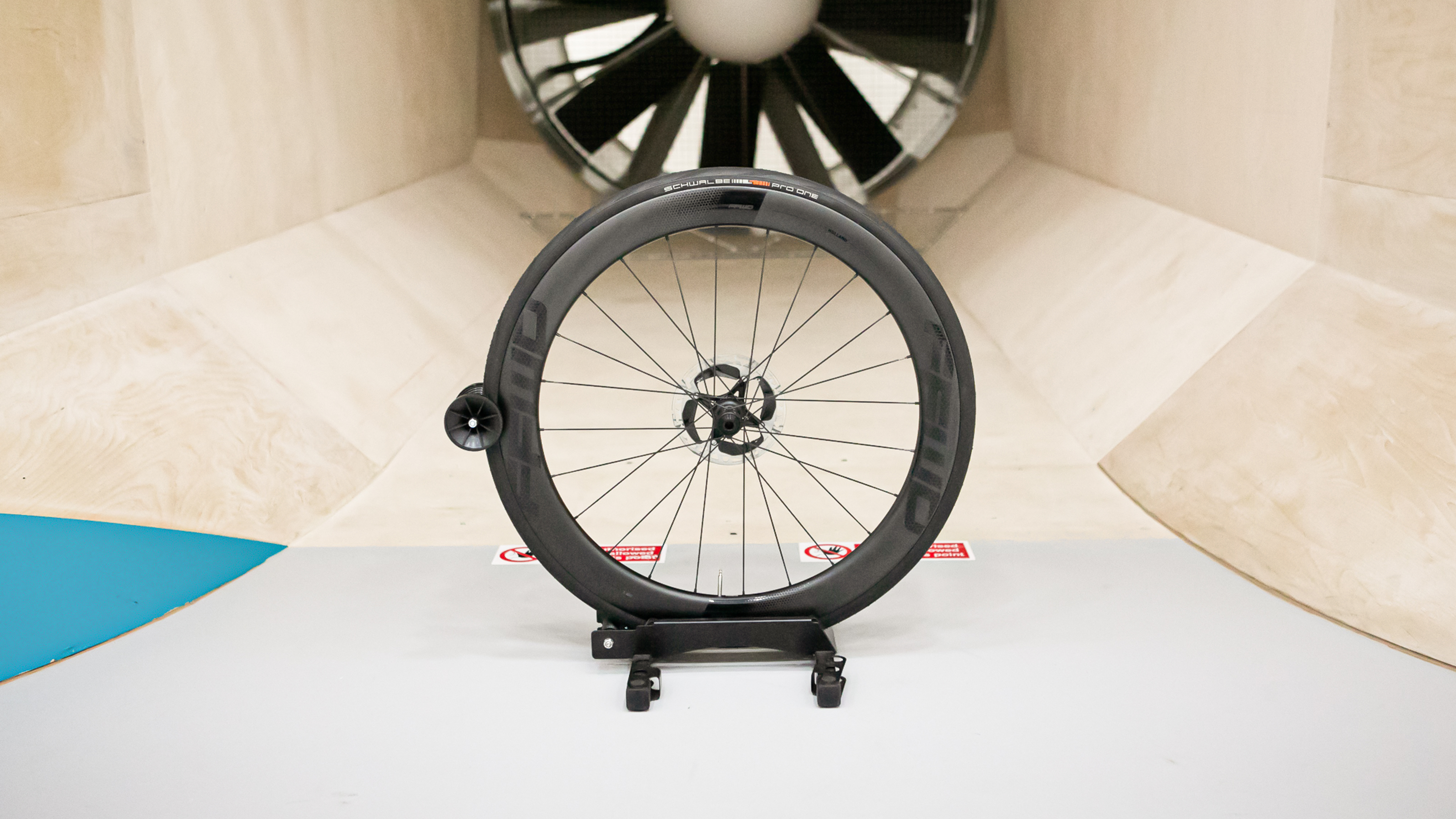
One of the wheelsets here designed for use with a 28mm tyre, the FFWD Ryot wheels were also disadvantaged by being some of the shallowest in our test at 55mm front and rear. With that in mind, they performed quite admirably.
They manage to save an extra 0.27 watts over the Roval wheels above at 40km/h, and that pushes them up to 1.26w faster than the Reserve wheels above at the same speed, or a touch over half a watt at 30kph. However, they were the heaviest on our test at 1750g.
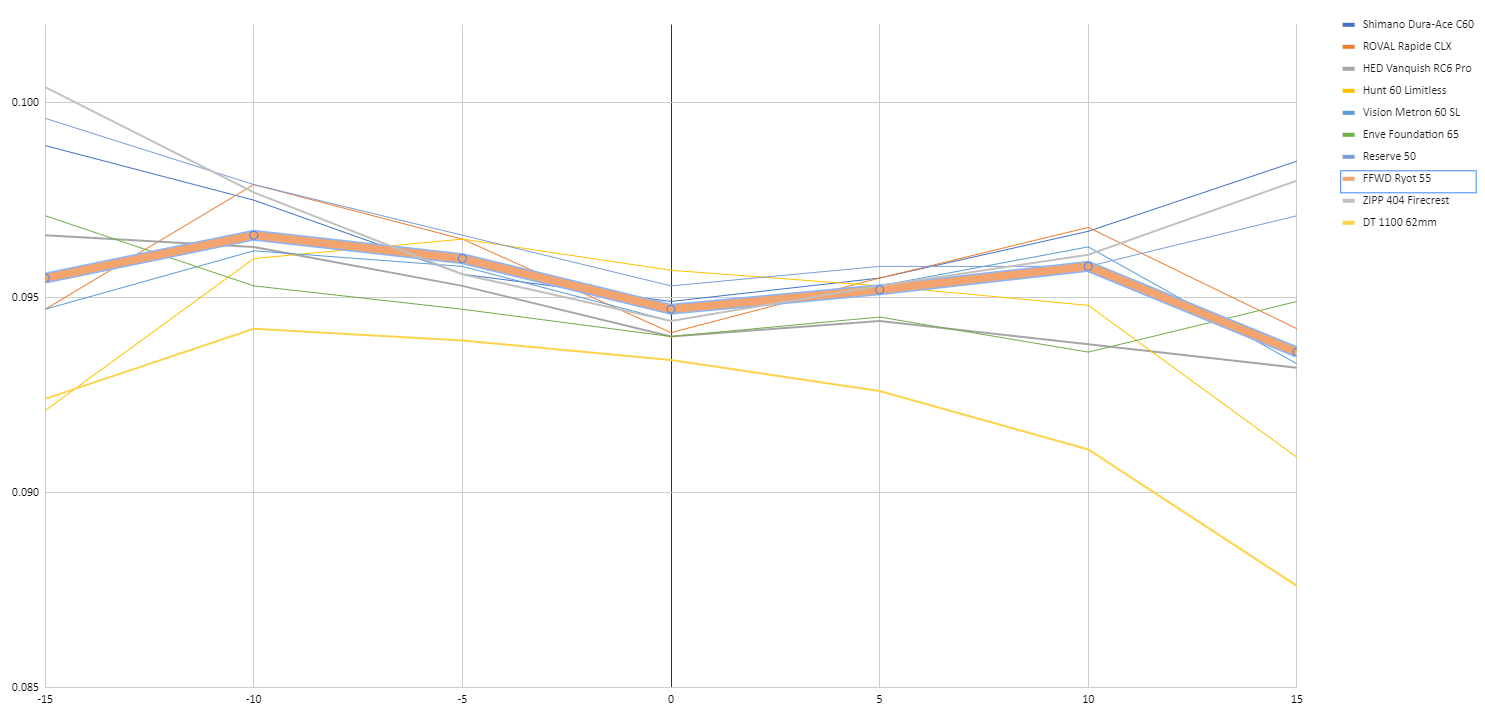
- Average CdA: 0.09534
- Rim depth: 55mm
- Internal rim width: 21mm
- Wheelset weight: 1750g
- Watts saved at 30kph: 0.53w
- Watts saved at 40kph: 1.26w
5: Vision Metron 60 SL
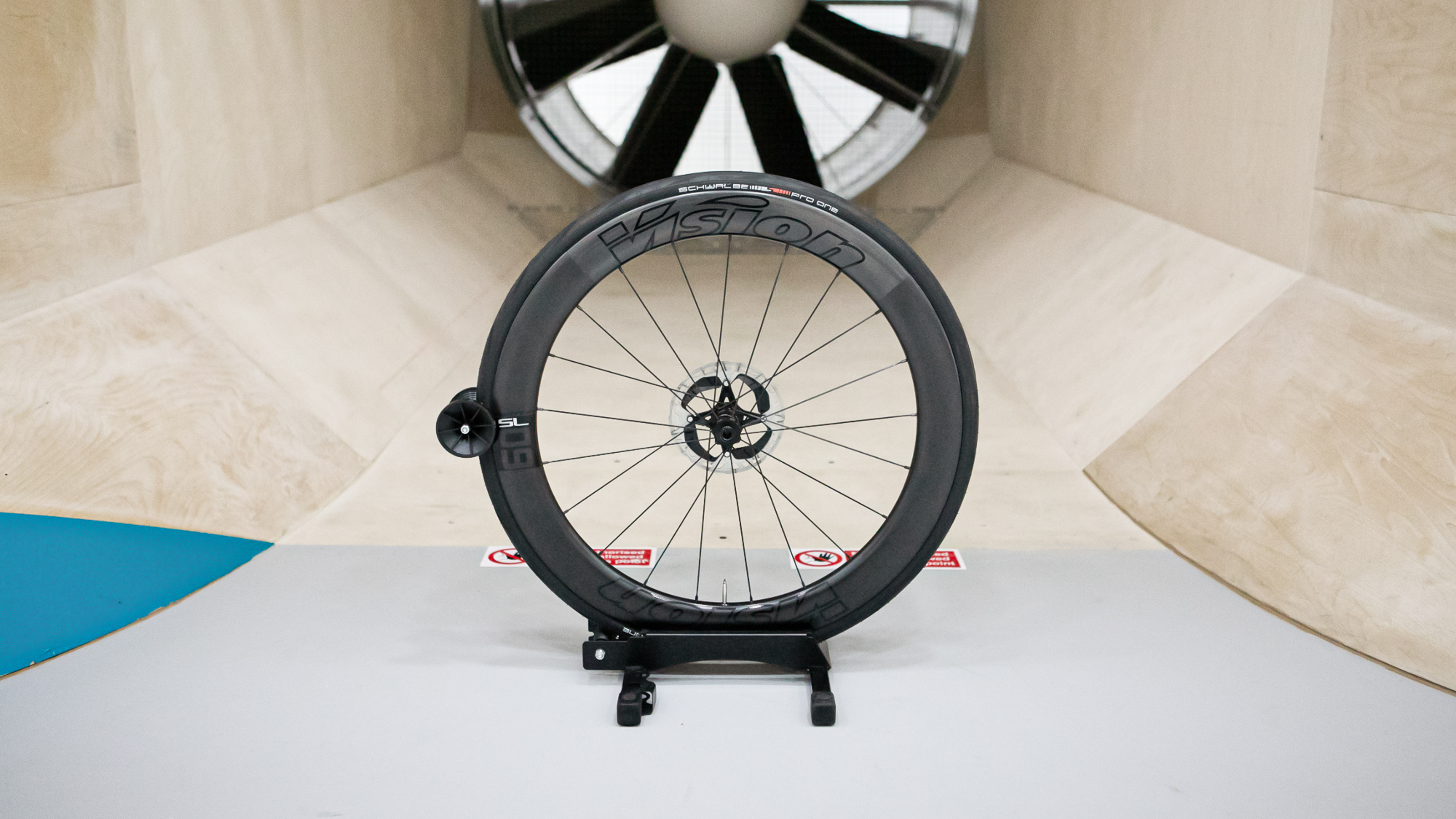
Vision has one of the largest presences in the WorldTour, sponsoring numerous teams with its wheels and other components, so it's natural that we wanted to include the brand in our testing. We chose the Metron 60 SL, and it provided a solid mid-table result.
With a CdA of 0.09514, they would save a rider 1.42 watts at 40km/h or 0.6 watts at 30km/h.
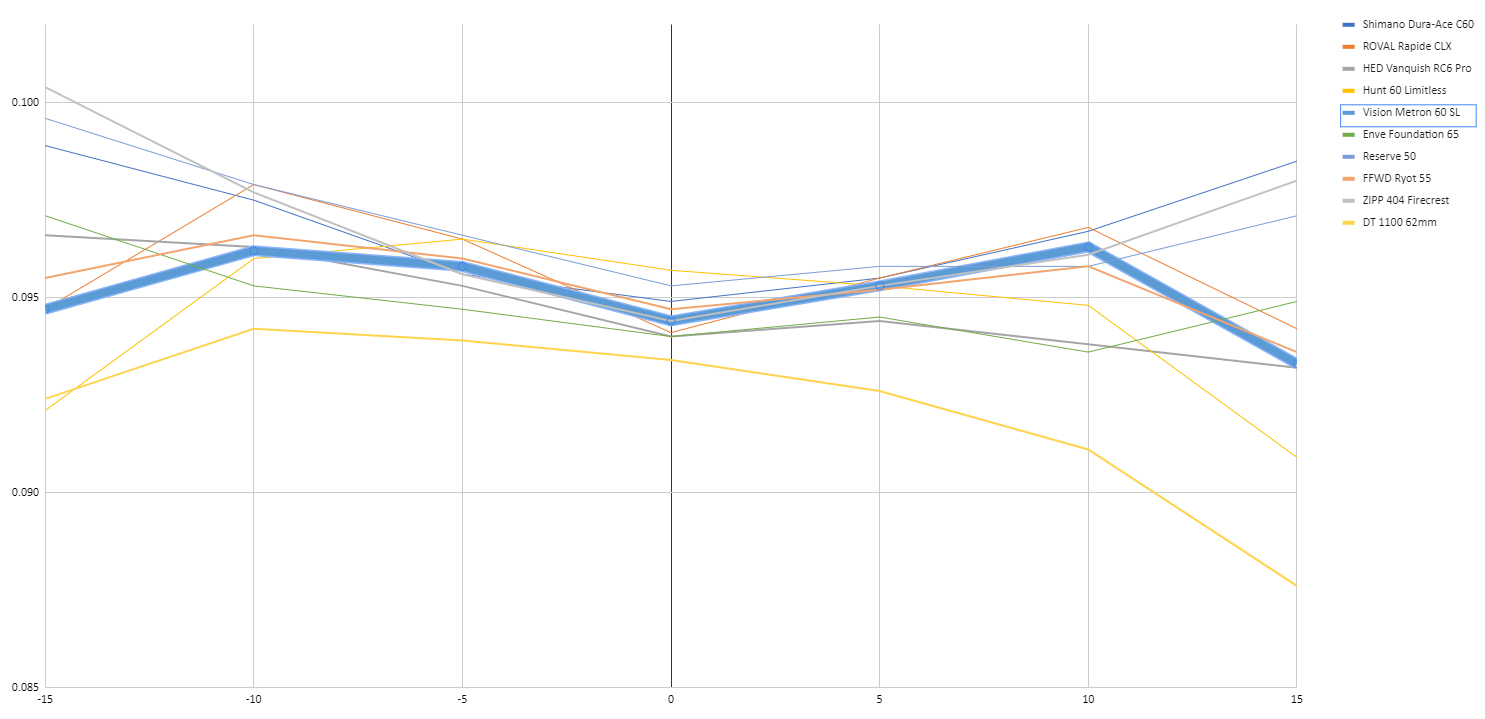
- Average CdA: 0.09514
- Rim depth: 60mm
- Internal rim width: 21mm
- Wheelset weight: 1460g
- Watts saved at 30kph: 0.6w
- Watts saved at 40kph: 1.42w
4: Enve Foundation 65
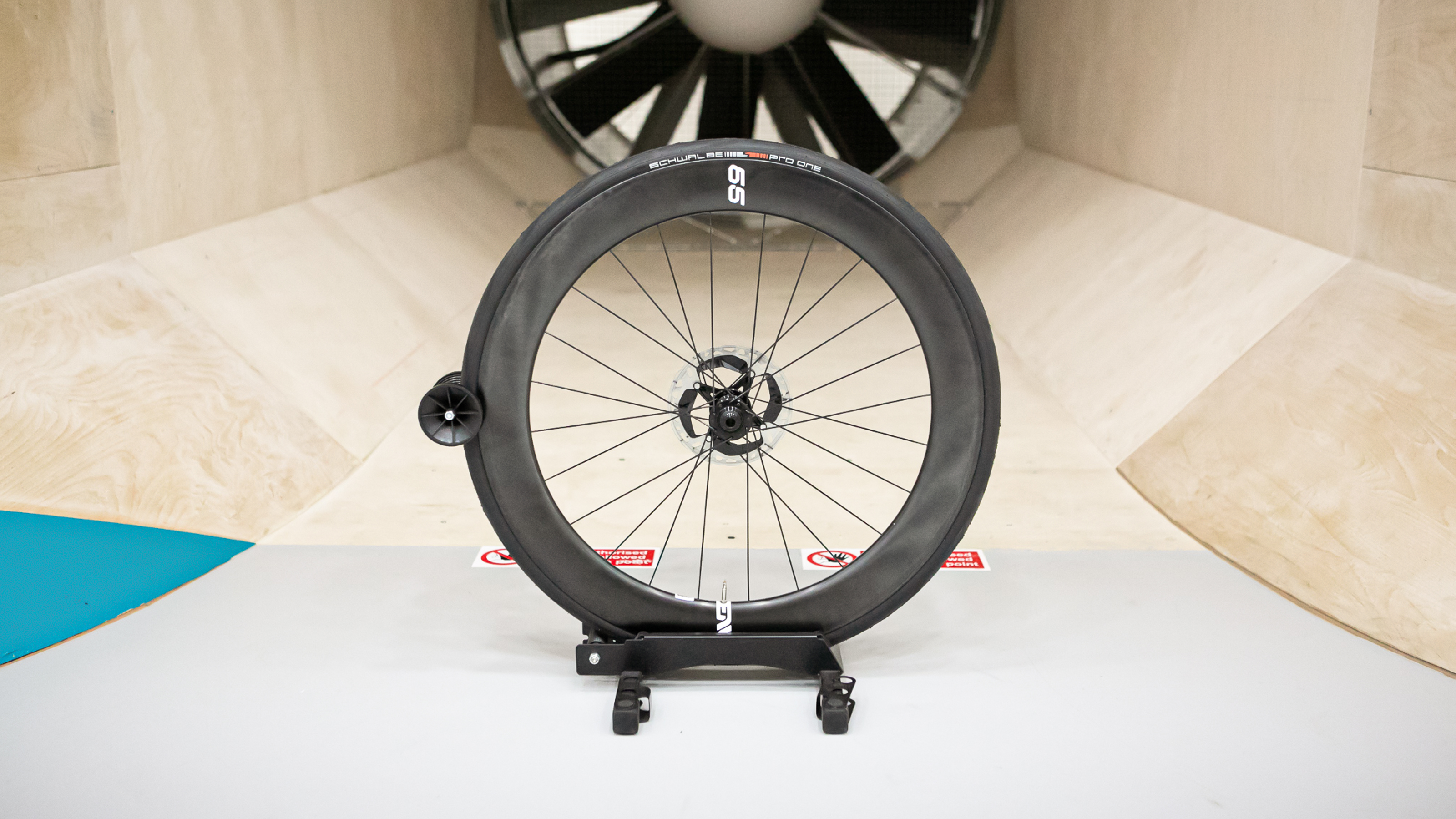
Unfortunately, the timing of our testing meant we couldn't get our hands on the new Enve SES 4.5 wheels, but we did instead manage to get the brand's cheaper Foundation 65 wheels, which are the brand's answer to the rising popularity of more budget-friendly carbon wheelsets like Zipp's 303S, Bontrager's Aeolus Pro, and Roval's Rapide CL wheels.
Despite that, they still yielded a solid aero performance in our test, with a CdA of 0.09487. That's a saving of 1.65 watts at 40km/h, or 0.72 watts at 30km/h.
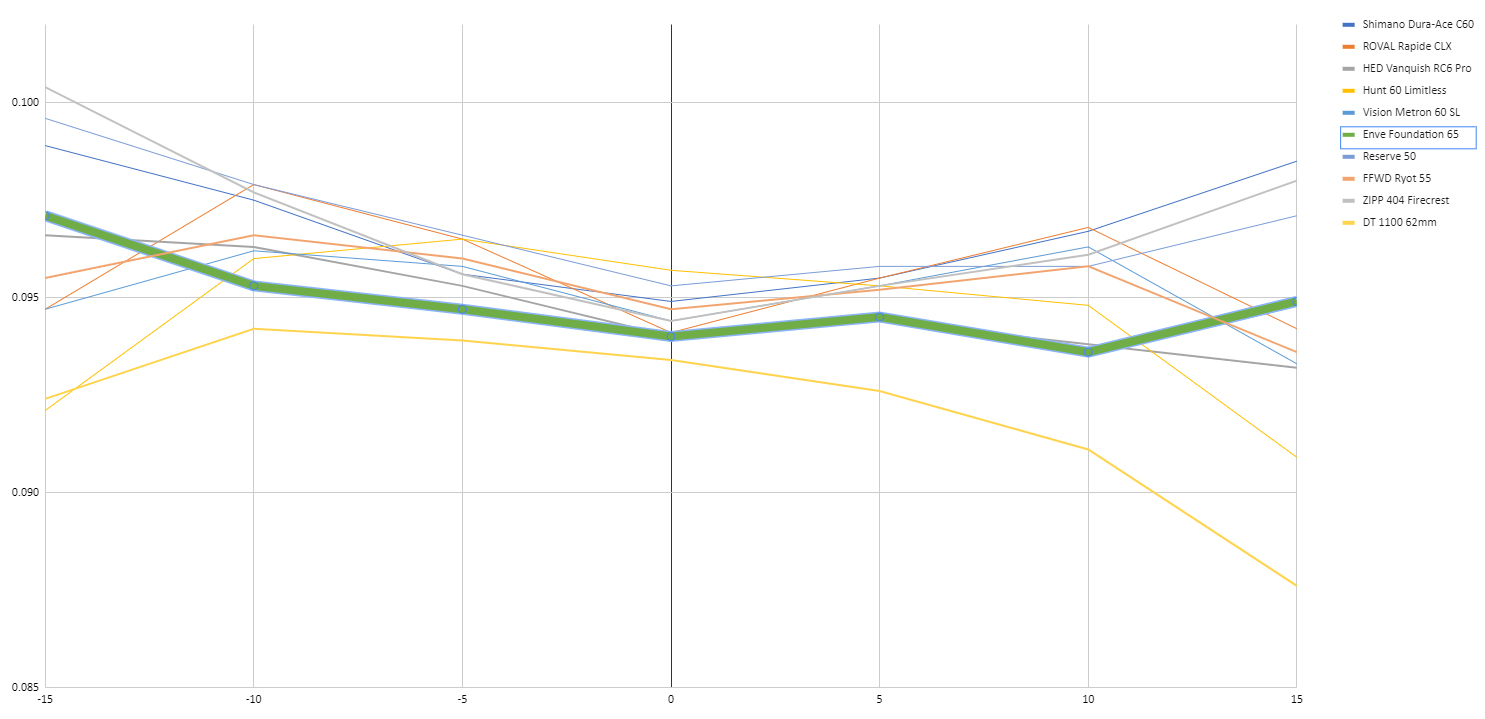
- Average CdA: 0.09487
- Rim depth: 65mm
- Internal rim width: 21mm
- Wheelset weight: 1630g
- Watts saved at 30kph: 0.69w
- Watts saved at 40kph: 1.65w
3: HED Vanquish RC6 Pro
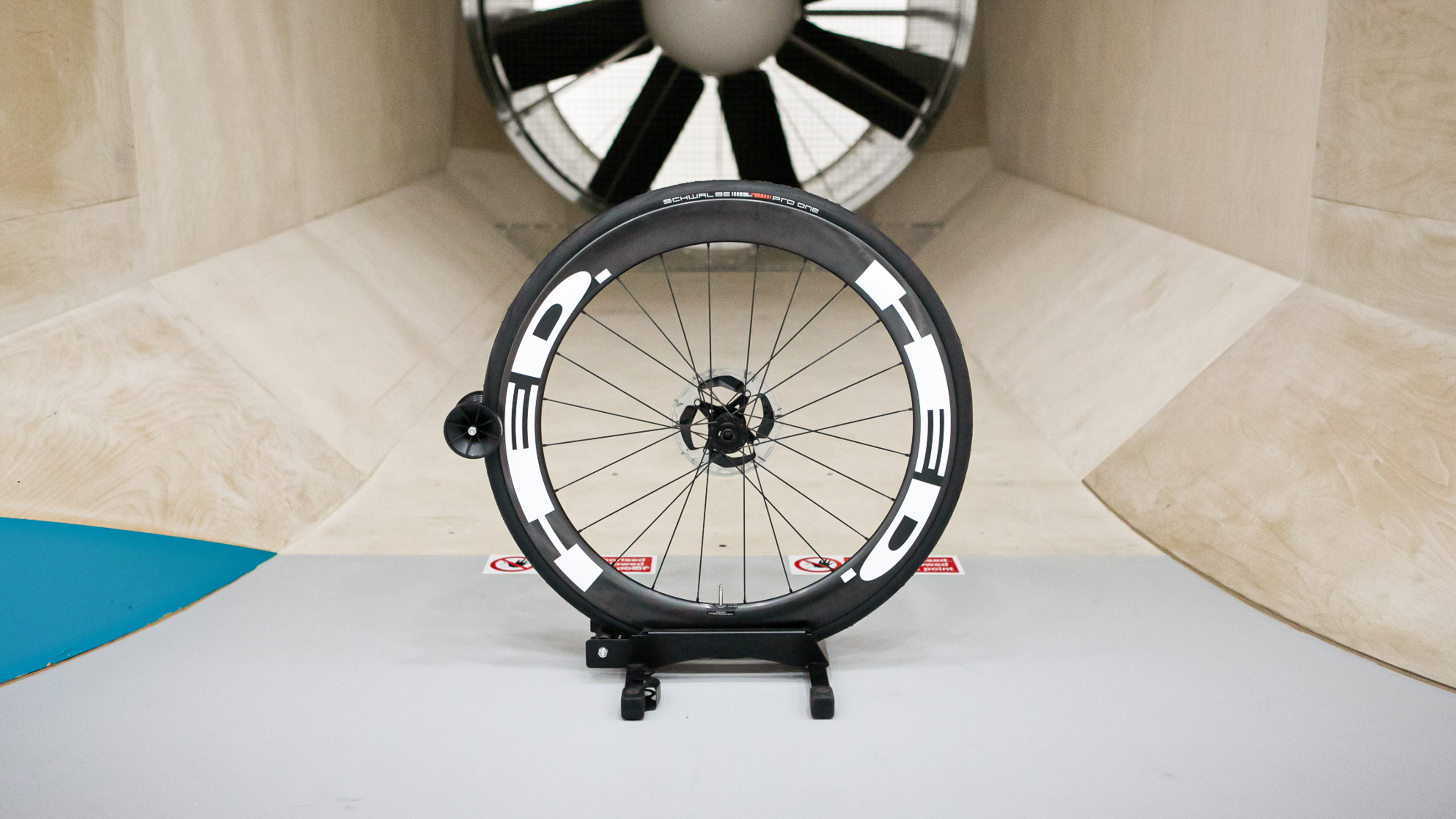
Now it's time for the podium, and occupying the bronze medal spot are the Vanquish RC6 Pro wheels, which are HED's very-top-of-the-pile option.
They sit at 60mm deep, with an internal rim width of 21mm and a weight of 1630g. Notably, that's the exact same weight as the Enve wheels above, and they only boast a very slight improvement in aerodynamics, with a CdA of 0.09480 and a saving of 0.05 watts at 40km/h.
That makes for a total saving of 1.7w over the slowest on test. Still not a lot, is it?
They have an external width of 30.6mm, and were designed to be at their fastest aerodynamically when wearing 28mm tyres. Sadly we ran out of time before we could test this.
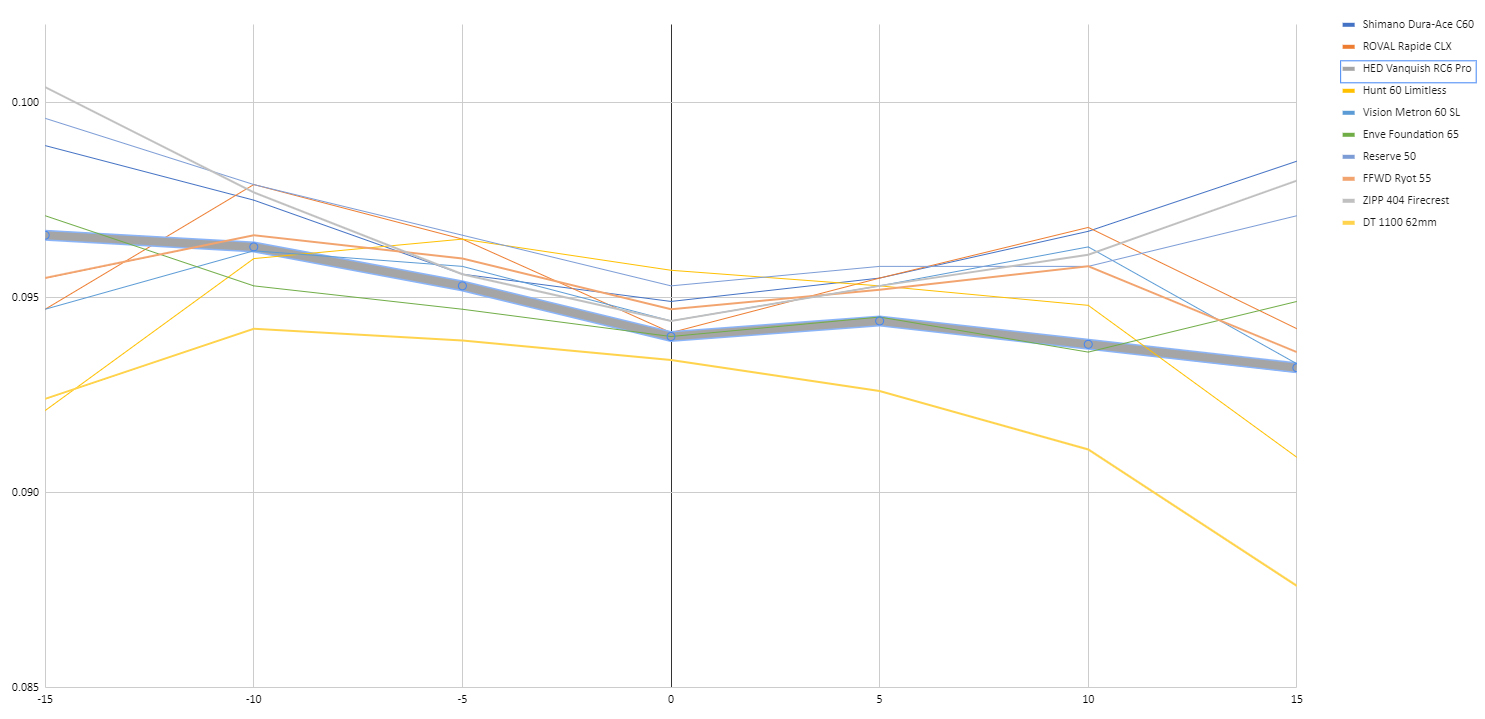
- Average CdA: 0.09480
- Rim depth: 60mm
- Internal rim width: 21mm
- Wheelset weight: 1630g
- Watts saved at 30kph: 0.72w
- Watts saved at 40kph: 1.70w
2: Hunt 60 Limitless Aerodynamicist
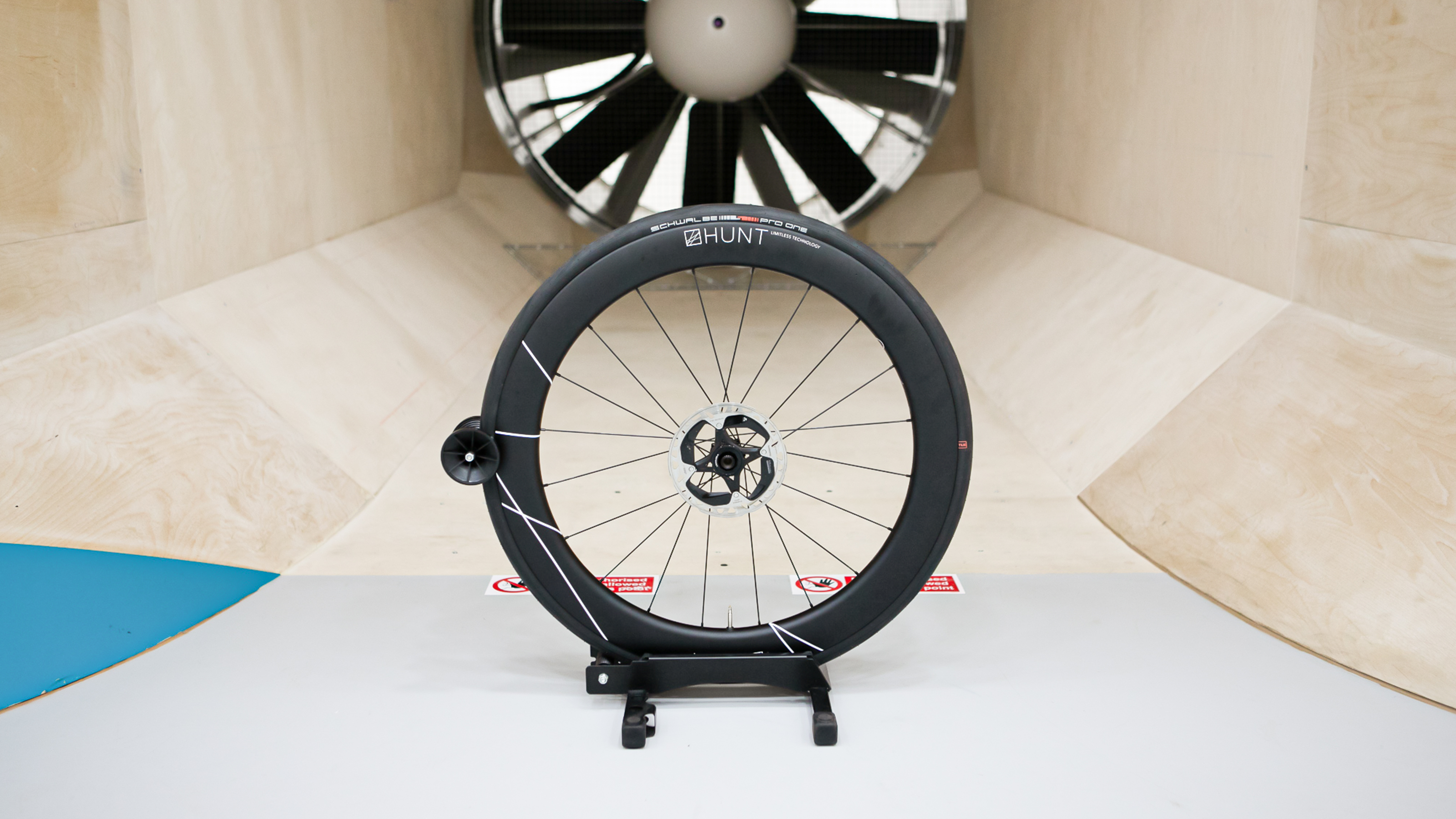
Into silver medal spot, and here we find the Hunt 60 Limitless Aerodynamicist wheels, which as the name suggests, are 60mm deep.
In our testing, they performed very well with a CdA of 0.09447, which equates to a saving of 1.98 watts at 40km/h and 0.83 watts at 30km/h.
Weighing in at 1670g, they come with the same 21mm internal rim width as many others on this list, but follow a similar pattern to the Roval Rapide wheels above by making them considerably wider externally, at 34mm compared for example to the HED wheels, which are 30.6mm wide.
These wheels are designed for 28mm tyres, which should mean they're disadvantaged by our testing protocol using 25mm, but surprisingly not. We had a little bit of time to play with at the end of our day, so we actually put these through the tunnel again fitted with 28mm tyres and found them to be slower, providing a CdA of 0.09537.
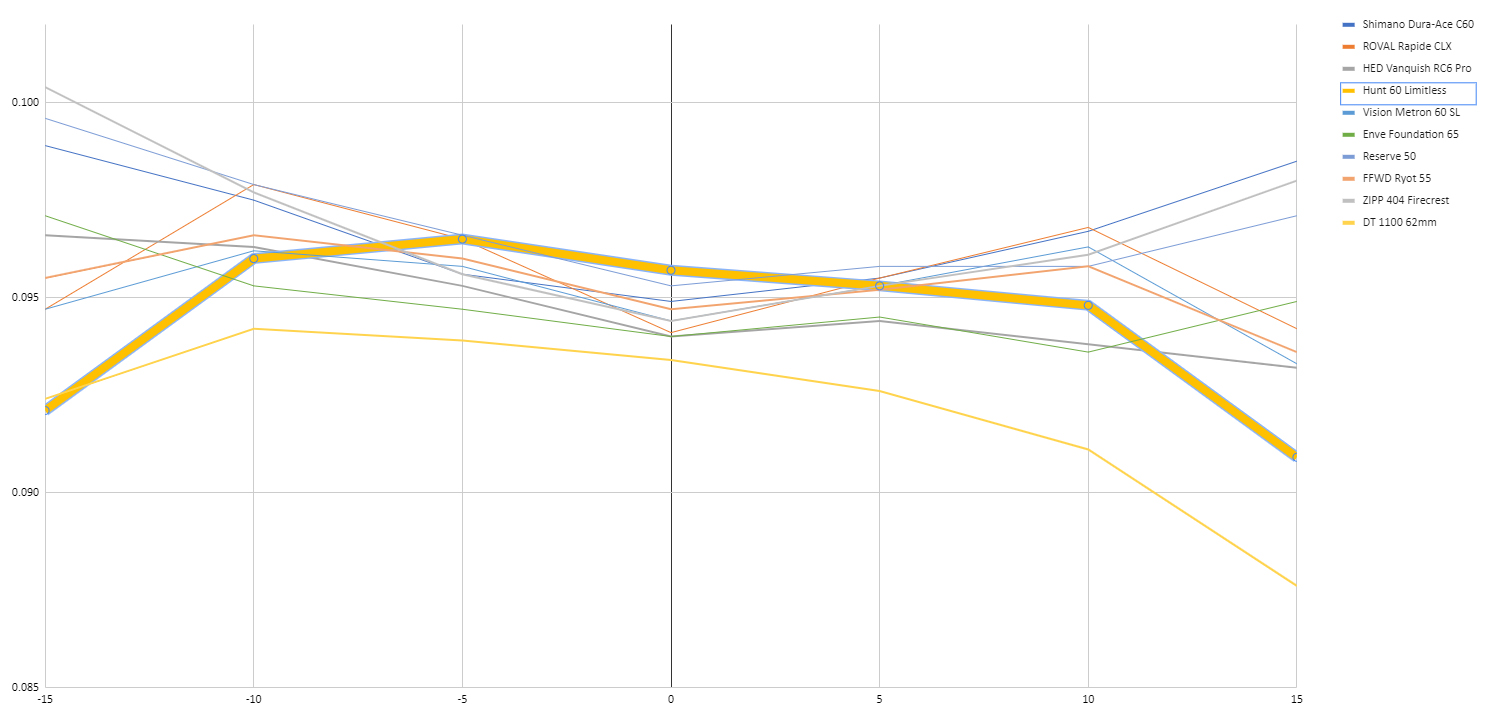
- Average CdA: 0.09447
- Rim depth: 60mm
- Internal rim width: 21mm
- Wheelset weight: 1670g
- Watts saved at 30kph: 0.83w
- Watts saved at 40kph: 1.98w
1: DT Swiss Arc 1100 DiCut 62

The top step of the podium and gold medal goes to DT Swiss, whose Arc 1100 DiCut 62 wheels were a bit of a runaway winner, providing a CdA of 0.09217. In terms of power numbers, that's a saving of 3.87 watts at 40km/h, or 1.63 watts at 30km/h. Therefore, based on the results of our time in the wind tunnel, if you're looking to buy a new set of mid-section wheels and aerodynamics matters most, then you should be looking at these.

- Average CdA: 0.09217
- Rim depth: 62mm
- Internal rim width: 20mm
- Wheelset weight: 1676g
- Watts saved at 30kph: 1.63w
- Watts saved at 40kph: 3.87w
Conclusion
We've mentioned it a number of times throughout this roundup, but it's important to recognise that the differences between the best and worst wheels in this test are very small. If you're able to average 40km/h, you're looking at fewer than four watts saved, and I'd argue that's most likely a time triallist, who would be looking at deeper wheels than these anyway.
A racing road cyclist might still average 40km/h but that will almost certainly be in a bunch, and in that environment, you'll make much more than a four-watt difference to your result by working on your positioning and your race tactics, not to mention optimising your position on the bike and other equipment.
A more typical road cyclist, riding alone and averaging 30km/h, will see even fewer watts saved; fewer than two watts between the best and worst here. Sure, if you're upgrading from a box-section alloy wheelset, then the gains will be greater, but spending too much time worrying about the difference between the aero performance of two high-end wheelsets is a fool's errand. As mentioned in our caveats above, if this is the position you find yourself in, our recommendation would be to find a wheelset in the ballpark, then ask yourself what else matters to you, so you can focus your energy on other considerations like ease of servicing, tubeless compatibility and more.
In fact, I'd go a step further and ask more questions: Have you already dialled in an aero position on the bike? Have you considered how fast your tyres are? Are you running tubeless, latex or TPU tubes instead of butyl? Have you invested in a fast skinsuit, an aero helmet, and aero socks or overshoes?
If not, then you shouldn't even look beyond the entry-level aero wheelsets.
With some wheelsets costing around £1,000 ($1,500) - Hunt's entrant in 2nd place is just £1,189.00 - and top-end wheels costing £3,000 ($4,000), the one to four watts you might save by buying a premium pair of wheels would present pretty awful value for money. And sure, a premium set of aero road wheels will definitely add to the visual appeal of your bike, but in a pragmatic approach to going faster, there are better ways to spend that money.
For £1500, you could even book a day in the wind tunnel with Wattshop themselves and ask them to make you faster. You could alternatively work through our guide of watts saved in order of spend and get faster by yourself. Or you could take a different approach and you could buy one of the best turbo trainers to make your training more efficient. You could do any of that, shave your legs, fuel your rides with more carbohydrates, eat less junk food, train more consistently, add strength training to your plan, or simply ride in a more aerodynamic position.
There are many ways to save (or gain) watts and buying fancier wheels is not necessarily the best, but if you've got everything else nailed down and you're looking for the biggest wattage saving you possibly can get in a mid-section wheel, then based on our time in the wind tunnel, DT Swiss' ARC 1100 DiCut would be the way to go.

Josh is Associate Editor of Cyclingnews – leading our content on the best bikes, kit and the latest breaking tech stories from the pro peloton. He has been with us since the summer of 2019 and throughout that time he's covered everything from buyer's guides and deals to the latest tech news and reviews.
On the bike, Josh has been riding and racing for over 15 years. He started out racing cross country in his teens back when 26-inch wheels and triple chainsets were still mainstream, but he found favour in road racing in his early 20s, racing at a local and national level for Somerset-based Team Tor 2000. These days he rides indoors for convenience and fitness, and outdoors for fun on road, gravel, 'cross and cross-country bikes, the latter usually with his two dogs in tow.